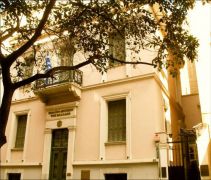The
Museum of Greek Folk Art has a rich collection of works of modern cultural heritage of about
20.000 objects derived from areas all over Greece and from areas where the Greeks acted, dating from the mid-17th until the 20th century.
It is located in the district of Plaka, on 17 Kydathinaion street, in walking distance from the Syntagma and Monastiraki metro stations in Athens.
The permanent exhibitions consist of excellent examples of
embroidery, weaving, local costumes, disguises, shadow theatre figures, silversmith, metalwork, pottery, wood carving, folk paintings and stone sculpture, highlighting the fundamental elements that shaped the cultural identity of the Modern Greeks.
The Museum consists of
four annexes:
The Main building at 17 Kydathinaion str., which houses the main exhibition hall, administrative services, the library, the part of educational programs and events hall.
The
Tzisdarakis Mosque, at 1 Areos Str. on Monastiraki Square, which houses the folk ceramics collection of V. Kyriazopoulos.
The
Bath House of the Winds at Kyrristou 8 str., the only one of the public baths of old Athens surviving to the present day.
The building at 22 Panas str., which houses the latest permanent exhibition,'' People and Tools: Aspects of Work in Pre-industrial Society'', with items donated by Company Folklore Studies.
The first Folk Museum in Greece was founded in 1918, founded by poet George Drosinis and archaeologist George Kourouniotis, under the name “Museum of Greek Handicrafts”. The museum had a collection of Greek handicrafts from all over Greece and the countries residing Greeks, from the Fall of Constantinople to the establishment of the Greek state.
In 1923, the museum was renamed in “National Museum of decorative arts” changing utterly the character and chronological limits of the collections. The collections enriched this period, even with material of archaeological excavations, if deemed appropriate to signify unity and continuity of Greek art. In the end of 1973 the permanent exhibition and the offices of the museum moved to the building at 17 Kydathinaion str., where they remain till today.
The ground floor of the museum is dedicated to embroidery and lace. On the mezzanine floor of the museum there is an exhibition with small ceramics, works of pastoral woodcarving figures of Greek shadow theatre and disguises. On the first floor of the main building there is an exhibition of objects granted by the inhabitants of the village of Olympos in Karpathos Island for exhibition purposes. The second floor of the museum is dedicated to presenting the works of silversmith: secular and ecclesiastical silverware from Thrace, Ioannina, Ionian Islands, Asia Minor, Pontus, Istanbul and Cyprus. The top floor of the museum is dedicated to presenting local costumes.

















